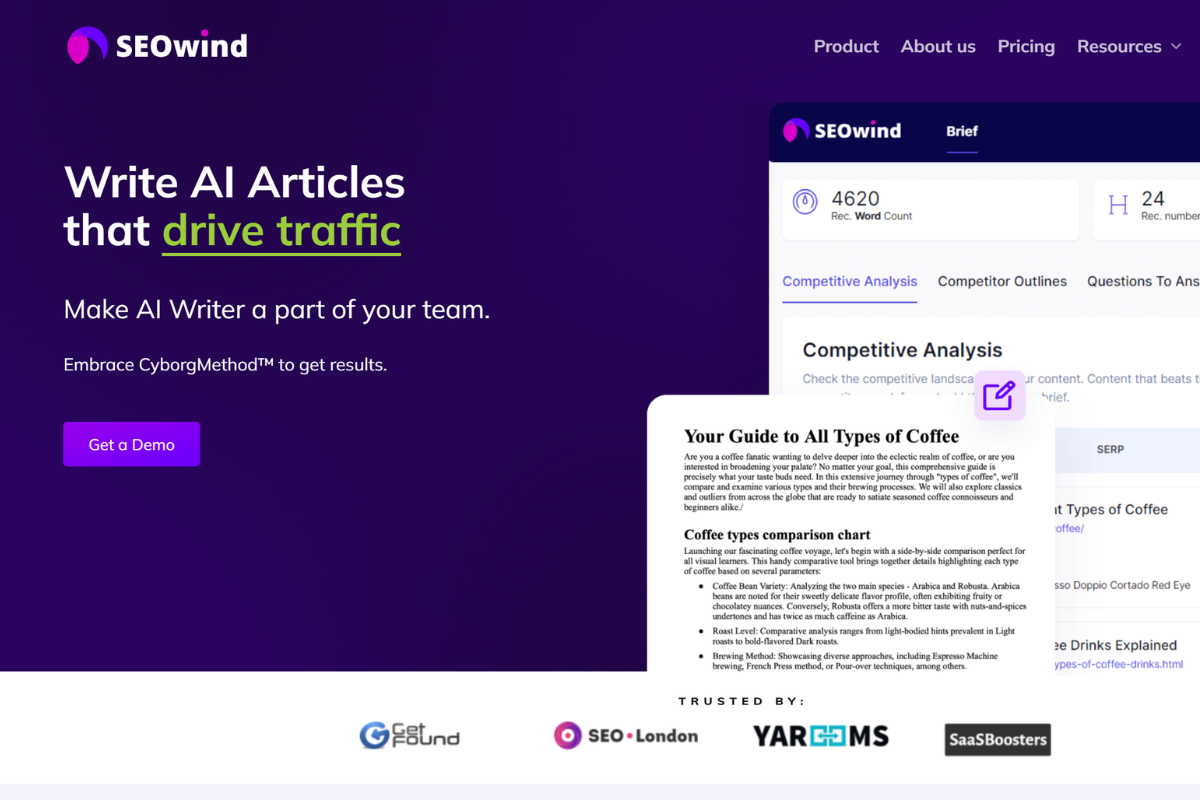Curious about what content briefs are and how they impact SEO? You’re not alone.
As you navigate blogs and other types of content, understanding the role and significance of a brief is crucial.
Here, we’ll outline what they are, the benefits of optimizing them, tips, tools, and examples for success.
Let’s get started!
What is a Content Brief?
A content brief is more than just a document; it’s your roadmap to successful content creation.
Soaking up inspiration from our day-to-day life experiences is bliss, but let’s not discard that organized planning and detailed scrutiny spare us unforeseen mishaps.
Creating a content brief can be likened to drawing up blueprints before constructing a building – it’s indispensable.
This groundwork includes capturing critical information such as the type of content, main objectives, target audience specifics, keyword inclusion, SEO OKRs, CTAs (call-to-actions), and desired visuals – all meticulously aligned with brand guidelines and messaging goals.
Signs You Need to Create a Content Brief
Need help with where to start each article or how to optimize it for SEO?
Perhaps engaging with your audience appears challenging—or worse—you’re blog growth is plateauing, despite sticking with ‘tried-and-true’ methods.
If these common roadblocks resonate with you—it’s time for an intervention—creating content briefs.
They are nothing less than strategic tools helping creators like you (and me) navigate topics while ensuring they are optimized for search engines.
Remember that clear goals lead to better results in any creative task.

What Should a Content Brief Include?
Crafting an efficient brief requires various elements. To produce high-quality, captivating content that will engage your target audience, your brief should include the following:
Overview
While developing a content brief, the starting point is always a comprehensive yet concise overview.
In bulleted points or short paragraphs, explain what the project is about and who it’s for. It is vital to understand your strategy — why this particular piece of content needs to be created and how it supports your broader business objectives.
It’s worth noting that if you’re working with a writer for a long-term project, this doesn’t need to be included with every brief. Instead, inform them early and ensure they are clear moving forward.
It’s also essential to define your target audience explicitly. Who are they? What do they care about? Why would this content interest them? Grasp these elements to ensure your work resonates with your goals.
Competition
Analyzing competition offers insight into their more effective strategies and highlights opportunistic gaps. It allows us to provide value by offering something our competitors haven’t considered or missed.
Incorporating competitor analysis into your brief enables content strategists and writers to establish what makes your voice distinctive. This information may guide decisions on tone and style or encourage alternative formats that set your brand apart.
Research
An effective content brief must underpin empirical research data. Including reliable data from trustworthy sources boosts confidence among readers that the content published is truthful, which consequently builds upon their trust over time.
SEO
Content creation guided by SEO best practices informs Google and readers about its relevance, leading to better rankings over time. Points related to keyword usage – primary keywords and secondary – meta-descriptions and other aspects should ideally find space in the master plan. Since we know how blogging helps SEO, keeping these aspects in mind is crucial.
Visuals
Visual aids, like images, infographics, or videos, can make large text more digestible and keep readers interested. They improve understanding and add style, making content more appealing and less repetitive for readers.
Calls-to-Action (CTAs)
Finally, yet importantly—every successful content brief must incorporate purposeful calls-to-action (CTAs). Whether seeking subscriptions to newsletters, downloading resources, or buying products/services, identifying what action you hope readers take helps dictate structure & tone.

Benefits of Using a Content Brief
There are significant benefits of making content briefs. Many may wonder, “What is a brief?” but once understood, the advantages become apparent.
Clear Communication
First and foremost, a content brief serves as a liaison representing clear communication between clients, project managers, and creative teams. The meticulous details in writing briefs ensure everyone understands what needs to be created, eliminating frequent rounds of revisions and boosting the team’s productivity.
Saves Time
Another advantage lies in time savings. Rather than spending countless hours deliberating on design elements or narrative angles, one can refer to the outlined requirements and expectations detailed in the content brief. This level of organization eliminates skirting around undefined areas and helps keep projects on schedule.
Fosters Creativity
Contrary to popular belief that strict guidelines limit creativity, well-defined content briefs encourage ingenuity within the set parameters. They offer a defined playground for creatives to let their imagination take over strategically without deviating from the main topic or goal.
Promotes Consistency
Content briefs have another unique selling point – they promote consistency throughout project deliverables. When everything from blog posts to social media aligns with the guidelines in your brief, an aligned narrative takes shape across all formats.
Increases ROI
Quality content briefs can lead to a better Return On Investment (ROI). A clear plan strengthens marketing efforts, targeting the right audience, increasing engagement, and boosting conversions. When you learn how to write a content brief, you realize it’s not just a routine document but a powerful tool for successful marketing campaigns. Speaking of ROI, want to learn if a monthly SEO retainer is a good fit?

Tips for Writing an Effective Content Brief
Writing an effective content brief might initially seem challenging, but don’t worry! With practice and the right tips, it gets easier:
- Stay Connected: Regularly updating your team about the plan ensures everyone’s on the same page. Discussing past projects’ successes and challenges can set the tone.
- Keep It Short: Remember to be concise while writing a content brief. Provide all necessary details without making it too wordy. This applies whether you’re listing deliverables, deadlines, or audience profiles.
- Customize for Each Project: Don’t use a one-size-fits-all approach. Each project is unique, so tailor your brief accordingly.
- Organize Information Clearly: Ensure your brief is easy to follow. Highlight main objectives early on, and avoid burying vital details amidst technical terms.
- Proofread Thoroughly: Mistakes in your content brief can lead to confusion and bad decisions. Always double-check before finalizing.
- Simplify Language: Avoid industry-specific jargon that might confuse your team. Use clear and simple terms whenever possible.
Remember, knowing how to write a content brief is essential for guiding your team effectively.
How to Write a Content Brief in 4 Steps
Creating a solid content brief requires several steps. Each step ensures you have a clear plan for top-notch content:
Step 1: Choose Your Story Angle
A strong story angle is the heart of great content. Pick a topic that fits your brand, resonates with your audience, and meets your goals. Use feedback and past content results to guide your choice. Ensure your topic supports the keywords you’ll add in the next step.
Step 2: Conduct Keyword Research
Keywords help your content show up in online searches. It’s crucial to include them in your brief. Tools like SEMrush and Ahrefs can suggest types of keywords for your topic. Choose ones that fit your story and are popular but not too competitive.
Step 3: Gather Your Internal Data
After identifying your keywords, compile other essential details. This might include information about your audience or past marketing successes. This internal data will be part of your brief’s “research” section. Remember, keep it concise and clear.
Step 4: Draft an Outline
Think of an outline as a blueprint. It breaks down your content from the start, through the main points, to the end. Each part should have a clear role, flowing smoothly from one to the next. While doing this, don’t forget SEO essentials, like optimizing headings and integrating keywords.
When it comes to SEO specifics, here are a few tips:
- Plan and look for internal linking opportunities
- Ask writers to include secondary keywords naturally
- Use keywords in heading titles, but don’t stuff them
- Use the FAQ section to answer related questions
- Your H1 heading should be reserved for the title
- Use H2, H3, and H4s throughout, as needed
- Try to include a FAQ section at the bottom

Content Brief Examples
To illustrate the concept of content briefs in different contexts, let’s review some examples.
Blog Post Brief Example
A blog post content brief is where it all begins for most online content creators. Using a brief can streamline generating an engaging piece that informs, entertains, or persuades your readership.
Let me give you an example:
- Title: The Impact of Climate Change on Biodiversity
- Audience: Environmental enthusiasts with a basic understanding of climate change
- Objective: To educate readers about how climate affects biodiversity
- Keyword(s): “Climate change,” “biodiversity loss”
Subheadings might include:
- Understanding Climate Change Fundamentals
- Effects of Global Warming on Wildlife
- Case Studies: Threatened Species Due To Changes In Habitats
CTA prompt could be like this: “Want to learn more about environmental conservation strategies? Sign up for our monthly newsletter.”
SEO Content Brief Example
Writing SEO-specific content requires slight variations from a regular blog post brief. You’ll need a tighter focus on keywords and meta-tags while fulfilling user intent.
See below an exemplar scenario:
- Title: Tips For Hiking Everest Base Camp Trek
- Target Demographics: Adventurous travelers aged 25-45
- Purpose: Provide actionable tips for successfully hiking Everest Base Camp trek.
- Primary Keyword(s): ‘Everest Base Camp Trek,’ ‘Hiking Tips’
Potential sections would embrace:
- Ideal Time of Year for Everest Base Camp Trek
- Essential Gear Required for Success
- Common Challenges Encountered & Suggestions
Concluding with a CTA like this works well: “Planning your next adventure? Purchase our detailed guide today!”

Content Brief Template
Making a good content brief is like bridging your plan and the final content. Think of a content brief template as your guide or blueprint to draft these detailed briefs.
Each section of this template serves a unique purpose, detailing different parts of the content you want to produce:
- Title: Although it might seem obvious, defining the title upfront does wonders for the central idea.
- Objective: This section defines what you hope to achieve with your brief, whether it’s brand awareness, lead generation, or boosting traffic.
- Target Audience: Knowing who your message should reach is critical; include their demographics, online behavior patterns, preferences, and pain points.
- Key Message(s): Clearly stipulate what messages need to be communicated through the piece of writing.
- Tone & Voice: Define how you want your brand personality reflected in the content – professional, casual, or humorous.
- SEO Keywords: List any SEO keywords that should be integrated naturally.
- Structural Details: Share specific guidelines about how you would like your post’s overall structure or segments to unfold.
- Calls-to-Action (CTAs): What actions do you want your audience to take after consuming your material? Buy something? Register on a website? Specify these precisely.
Remember that this template serves as just an example – customize it according to individual project requirements and feedback from creative teams.
Common Mistakes to Avoid
Creating a content brief is more than just putting words on paper; it’s deeply understanding your brand, audience, and goals.
As simple as it sounds, many fall into pitfalls that diminish their brief’s effectiveness.
Avoid these common mistakes:
- Forgetting Your Audience: Recognize who you’re addressing. Each audience segment has unique preferences and concerns. Don’t generalize; be specific.
- Being Too Vague: Clarity is essential. Provide clear, detailed descriptions so everyone knows what’s expected.
- Over-focusing on SEO: While search engine optimization is vital, don’t sacrifice content quality for keywords. Strive for a balance: relevant content with strategic keyword use.
- Overlooking Competitors: Pay attention to your competitors. Learn from both their successes and failures to enhance your strategy.
- Omitting Calls to Action (CTAs): Without clear CTAs, you miss chances to engage readers further. Always guide them to the next step.
- Planning in Silos: Don’t just focus on the content; consider how it fits into the broader marketing strategy. Ensure alignment for the greatest impact.
- Neglecting Visual Content: A wall of text can deter readers. Mix in visuals to maintain interest and enhance understanding.
Remember, writing a successful content brief means dodging these pitfalls and embracing best practices for any campaign.

Tools for Creating & Managing Content Briefs
Many tools streamline content brief creation and management. Embracing these platforms is becoming a cornerstone for marketers. Leveraging them not only boosts productivity but also refines team coordination.
Here are a few of our favorite tools:
Google Docs
Firstly, let’s explore Google Docs. This tool offers real-time collaboration benefits, allowing ease of access to everyone involved. It has built-in suggestions and review features that make the drafting process more efficient by enabling simultaneous edits and feedback.
Trello
Next on our list is Trello. Known for its card-based system, Trello allows users to create individual tasks (cards), organize them into groups (lists) according to stages or categories, and move them around as necessary – an excellent feature for visualizing workflow!
Airtable
Airtable takes things slightly higher, blending spreadsheets’ simplicity with robust databases’ complexity. It’s a versatile tool for organizing content plans, tracking timelines, and integrating multimedia assets into your workflow.
Ahrefs
For SEO research, Ahrefs come into play; they provide profound insights about keywords related to your content topic. By helping you understand how competitive certain keywords are and identifying less competitive ones that can still generate traffic, they lead you towards better optimization of your content briefs.
SEOwind
Last but certainly not least is SEOwind, an AI content brief generator.
This is one of our favorite tools. For good reason, add your focus keyword. SEOwind does all the heavy lifting: It reviews competitors, collects secondary keywords, optimizes titles, meta descriptions, and heads, and then uses AI to generate a brief. Want to take it one step further? Use its AI writer to write the article!

Conclusion
Understanding content briefs is crucial. Think of them as blueprints for content, guiding creatives to produce work that fits a brand’s message and audience needs.
Without them, it’s like building a house without plans—you might be able to do it, but at what cost? A well-structured brief—covering topics like competition analysis, SEO, and clear CTAs—ensures content is detailed and concise.
We hope this guide has served you well and you can make content briefs that bring your strategy to new heights.




![Featured Image - Mental Health Content Writing [Best Practices and Ethical Considerations]](https://trioseo.com/wp-content/uploads/2024/05/Mental-Health-Content-Writing-Best-Practices-and-Ethical-Considerations-300x157.png)
![Featured Image - Beginner’s Guide to CBD Content Writing [Tips Included]](https://trioseo.com/wp-content/uploads/2024/05/Beginners-Guide-to-CBD-Content-Writing-Tips-Included-300x157.png)

![Featured Image - [Ultimate Guide] SEO For Tech Companies That Outranks Competitors](https://trioseo.com/wp-content/uploads/2024/04/Ultimate-Guide-SEO-For-Tech-Companies-That-Outranks-Competitors-300x157.png)

![Featured Image - B2B SaaS SEO - Ultimate Guide [Strategy Included]](https://trioseo.com/wp-content/uploads/2024/04/B2B-SaaS-SEO-Ultimate-Guide-Strategy-Included-300x157.png)

